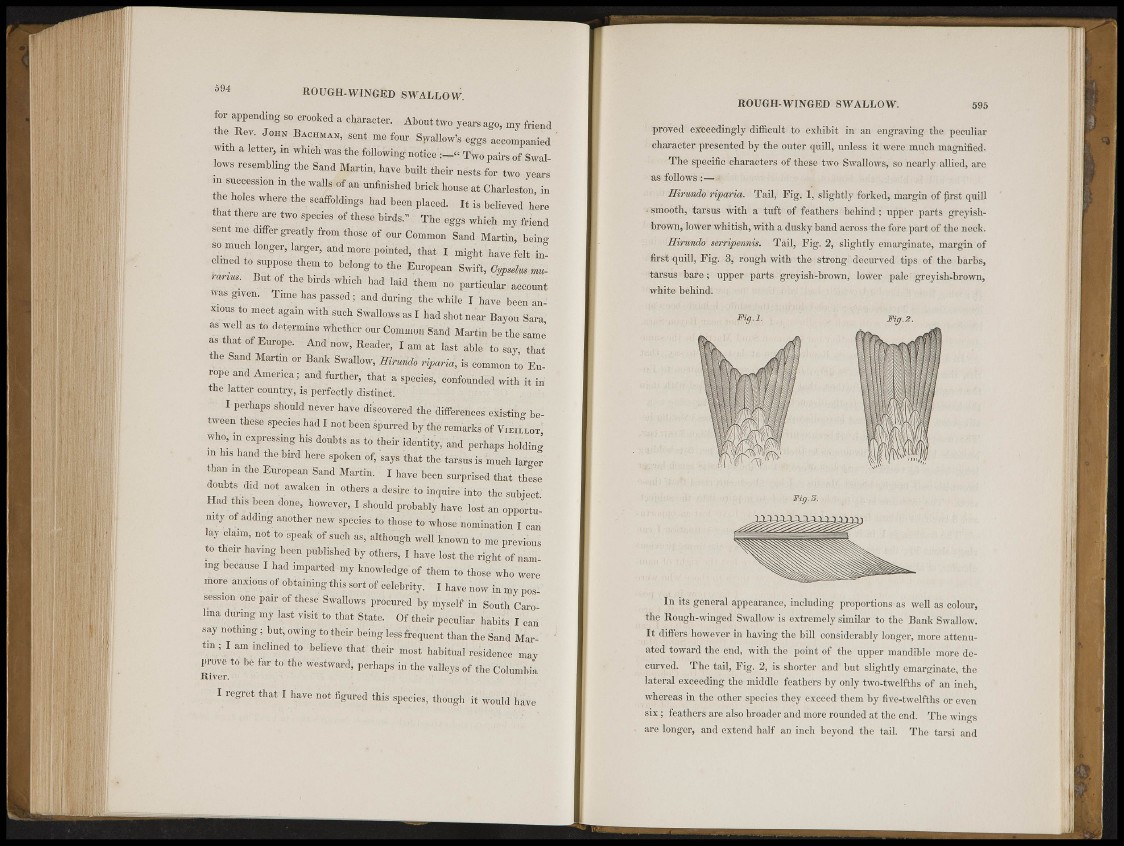
594 R O U G H - W I N G E D SWALLOW.
for u p p e r s Soc,-ook,;d:a,.Aarador. Abouttw.o.ye^ago^y.fiiend
the B ^ . JOHN IW, i h a , ; ,S(mt m o f o u r S w M m g g s a^ompanied '
wrth « ^ « - t r l u o h was the TWo pairs of Swallows
resembling the Sand Martin, I n b u i l t their nests for. two years
in Succession in the waflsWf a» unfinished brick house at Charleston in
fte holes where the scaffolding« had llteplaeed. It is belfevM here
that there are two species of the*,, bird*.'" The eggs-Whieh my « end
•sent me differ greatly from those of our Common Sand Martin, being
so much linger, larger, «ad more pointed, that I might ^ e , f e l t inc
h e d to suppose them to belong to the European S^ift, Obelus
• Bu t i * » - W f t had laid them'«, particular, account
lV:'S g,V<!"- Time h a s I ® « saWI luringvthe while: I ha« boon anxious
to meet again with'such S w a l l o ^ I hadstfotnear Bayou Sara
MMSB • • B «'»•(:.,„„„„„ Sand Martin —
as t ^ t of Europe. Anft-ujjw, Reader, I am at last ableVlay, that
the Sand Martin or Bank Swallow, HMjo riparia, is common t o •
r l p a n d America; and further, that a confounded with it in
the latter country, is perfectly distinct.
- I perhaps should niver have discovered the'diffeeiices esistAg between
these s p e c * had I not bee« Spurred by the remarks of Vi k„.,„T
who, in «pressing his doubts^ to their identity, and perhaps holding
in his hand the bird here spoke* offjsays that the tarsus is much larger
B "' O B I • m M I • been surprised .hat those
E B H B B B • - 1 H H i S l the subject.
Had this been done, however, I should probably W loW an opportu-
, mlv of adding another new to those to whose nomination I can
lay claim, not »"speak of such als, although wM known to" me previous
to their having-bein published by others, I h a v e » t the right of nam
ing because I had imparted :my knowledge of them'to thbse who were
more anxious of obtaining this sort of celebrity. I have now inruypos
sessmn one pair of th,,s,i Swallows procured by myself in S„ m ! l (•„„.
lina during my la,t visit to that-State. Of their peculiar habits I caa
say nothing; hut; „wing f.,their Inmates frequent than the Sand Mar
trn; Iam mclinedto belfevfe that their most habitual rtsideMe may
prove to be lar to the westward, perhaps in the v a f f i p t f t h e Columbia
River.';
' i that I have not figured this «pocies,'thrtugh it would have
R O U G H - W I N G E D SWALLOW. 595
proved exceedingly difficult to exhibit in an engraving the peculiar
character presented by the outer quill, unless it were much magnified.
The specific characters of.these two Swallows,; so nearly allied, are
as follows:—
Mirwndo riparia. Tail, Eig. I , slightly forked, margin of ^rst quill
'Smooth, tarsus with1 a, tuft-of feathers behind; upper parts greyishbrown,
lowerwhitish, with a dusky band across th® fore: part of the neck.
Hinmd/o' semipmtm. Tail; Fig. 2, slightly emarginate, margin of
first quill, Fig. 3, rough with the strong; decurved tips, of the barbs,
•tarsus bare; upper parts greyish-brown, lower pale; greyish-brown,
white', behind.
ms.2.
—
J « •itll
HHc/.i
In its general appearance, including proportions as well as colour,
the Bough-winged Swallow is extremely similar to the Bank Swallow.
It differs however in having the bill considerably longer, more attenuated
toward the end, with the point of the upper mandible more decurved.
The tail, Fig. 2, is shorter and but slightly emarginate, the
lateral exceeding the middle feathers bv only two-twelfths of an inch
whereas in the other species they exceed them by five-twelfths or even
six; feathers are also broader and more rounded at the end. The wings
are longer, and extend half an inch beyond the tail. The tarsi and